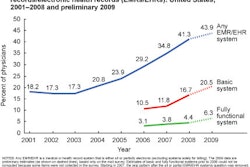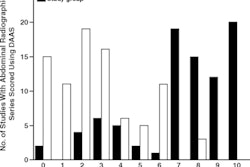One of the challenges in reducing CT radiation dose is that many institutions don't have automated methods for tracking a patient's past scans. A Rhode Island health system addressed this issue with software that issues alerts for at-risk patients who have received multiple studies.
Whenever a new CT is ordered at three hospitals in the Lifespan health system in Rhode Island, an internally developed application warns the ordering physician if prior exam volume exceeds a defined threshold for that patient. Although the software's effect on ordering behavior hasn't yet been calculated, the researchers believe it offers significant potential for reducing duplicate CT exams.
In a scientific session at the 2009 RSNA meeting in Chicago, Dr. William Mayo-Smith of Brown University in Providence, RI, presented the Lifespan network's experience with the software.
With the dramatic increase in the number of CT imaging exams, many patients have received multiple scans, and the potential exists for duplicate studies to be ordered. In response to this phenomenon, Lifespan developed a software program that tracks each patient's scan history by querying the hospital network information system and counting the prior CT exam volume by body part.
This process is performed whenever an electronic imaging order is placed at Rhode Island Hospital (a 750-bed teaching hospital and level I trauma center in Providence, and the primary affiliate of Brown Medical School), Miriam Hospital (a 250-bed community hospital in Providence), and Newport Hospital (a 130-bed community hospital in Newport).
Patients have traditionally had separate medical record numbers for each of the hospitals, but also a unique identifying number for within Lifespan network. Using a data-mining algorithm, the application searches the Lifespan database for prior CT exams performed across the three institutions.
For patients younger than 50 years and who have had five or more prior CT exams, the application will present the ordering physician with the results and a radiation warning alert. The warning message informs the physician that that patient has had multiple CT examinations in the Lifespan system, and that radiation from x-rays and CT act in a cumulative manner.
"The cumulative amount of radiation received by this patient will now likely be at a level where scientific data has shown increased risk of radiation induced cancer," the warning states. "Please consider this when ordering an additional CT exam and contact a radiologist with questions for alternative imaging tests."
Data are presented to the ordering physician in table format in near real-time, broken down by brain, neck, chest, abdomen, pelvis, and extremity categories. In the table, one column provides the number of exams the patient has received by body part since 2001, while a separate column provides exam information in the past 12 months. Orders for patients with fewer than five exams or who are 50 years or older will not generate a warning.
The system was implemented in September 2008 and retrieves CT exam information in an average time of about seven seconds. From January to September 2009, there were 15,926 electronic orders for CT exams in Lifespan. Warnings were generated in 2,100 cases (13.2%).
A software add-on was also added to the institution's separate emergency room ordering system, allowing ER physicians to search for prior CT exams. In six months of that system's use, 21,000 CT exams were ordered by the ER. In these exams, the application performed 5,962 searches (28.4%).
"We know that they're using this, but we don't know exactly how much their behavior is being modified," Mayo-Smith said.
The system does have its limitations, however, as only 46% of imaging orders at Lifespan are placed electronically. In addition, it does not account for the majority of outpatient or ER imaging orders.
Nonetheless, the warning system offers the promise of fewer duplicate exams and has been successfully implemented across the Lifespan network, Mayo-Smith said.
By Erik L. Ridley
AuntMinnie.com staff writer
January 28, 2010
Related Reading
QA software automates CR reject analysis, December 23, 2009
Studies spotlight high CT radiation dose, increased cancer risk, December 14, 2009
Shock and awe over JAMA editorial, October 22, 2009
NEJM study: Imaging procedures, radiation growing, August 26, 2009
Australian software automates data mining of CR dose, September 9, 2009
Copyright © 2010 AuntMinnie.com




















